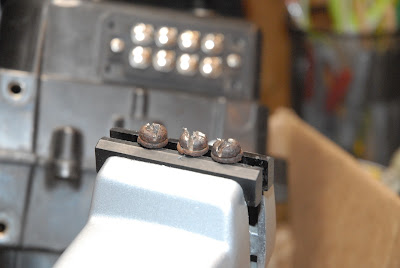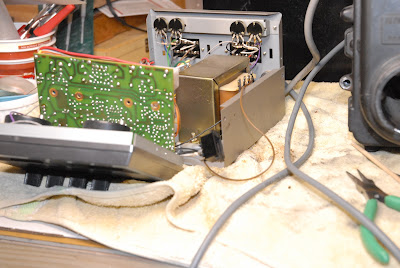Besides listening to the shortwave and tinkering in the shop, I've been helping with some home improvement projects the SWL decided she wanted to do. We're getting new flooring installed in all four bathrooms and the laundry room, along with removing the carpet from the stairs, and putting laminate on them, too.
Some demo work on the stairs. These are the short set of stairs from the main level to the den/laundry level:
And the main stairway:
The vertical pieces are wood, and the treads are MDF with a finished, rounded front edge. And of course, the sent our installer/handyman guy the wrong size. ARRRRGH!
This is the laundry room looking into the #3 half-bath/powder room:
Just about finished down here, but over half the baseboards they sent our guy were the wrong ones......DOUBLE ARRRRRGH! And it's going to take 14 days to get the replacements. The bathroom is finished, but he only had enough of the correct baseboards to do half the laundry room, so he did the "hard half" so we could get the washer and dryer back on-line ASAP.
So, everything has slid to the right by two weeks. Looks like now I'm going to have to buy some nice wood wall plates for the outlets and switches so the rooms look "finished".
And down in the "Wizard's Workshop" I put the repaired Heathkit Total Harmonic Distortion Meter to it's intended use for the first time. Yes, it's been rebuilt, and all the alignment/calibration tests went by-the-book after it was repaired, but how well does it actually work? Can I believe the measurements it makes? Are they reasonable, and do they "make sense" and look "real"? Are they repeatable?
So far, the answer appears to be yes to all of the above. I have four audio signal generators, so I set up a shoot-out test to see which one was the "best" in terms of lowest distortion. The results were as expected, and repeatable. I used a 1kHz, 2vRMS signal from each generator, and compared them to each other on the Heathkit. These are relative measurements, not absolute, as I have no calibrated source of specific levels of distortion to test the Heathkit analyzer with.
Up first was my newest unit, the HP 8904A Multifunction Synthesizer. As expected, it showed the lowest level, reading .02% THD.
Next up was a Heathkit SG-1272 Audio Generator, which read a little under .03% THD.
Next was another Heathkit generator, the IG-18 Sine-Square Audio Generator, showing a bit under .1% THD (found my notes) .05%. which surprised me a bit, as this one was modified for improved performance. It's better than the Heath spec, which is "Less than .1% from 20Hz to 20kHz", but I've read where some of these modified units can be better than .02%. It's very touchy to get calibrated, and I could probably tweak it a bit while connected to the analyzer to improve. Didn't take a meter photo, but it's the middle brown box here:
And coming in dead last, is the audio generator section of the Heath IG-37 FM Stereo Generator at a staggering FOUR PERCENT of THD. Look where the range switch is set. I had to go UP three ranges to measure it.
This thing's going on the block to get it OUT of here!
And I'll go through the IG-18 generator to see if I can clean it up a bit without a lot of effort. I have far better test equipment to use than the two old Heathkits, but they'd be OK for somebody just starting out.
Hope y'all have a good week ahead.





























